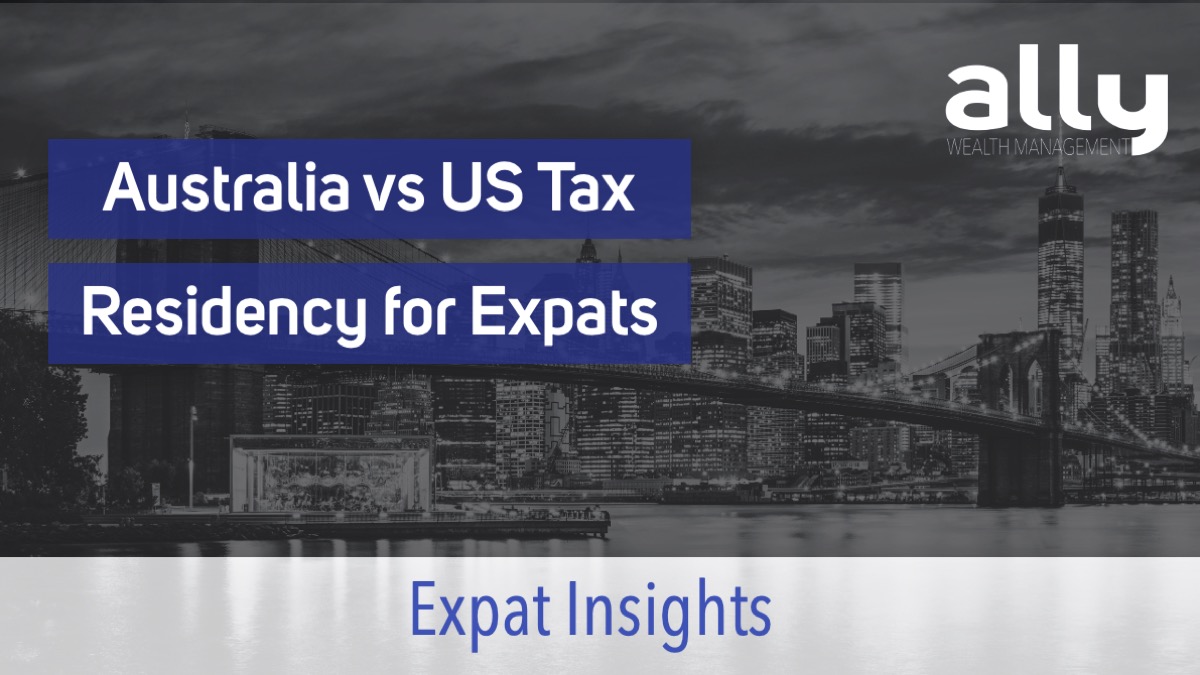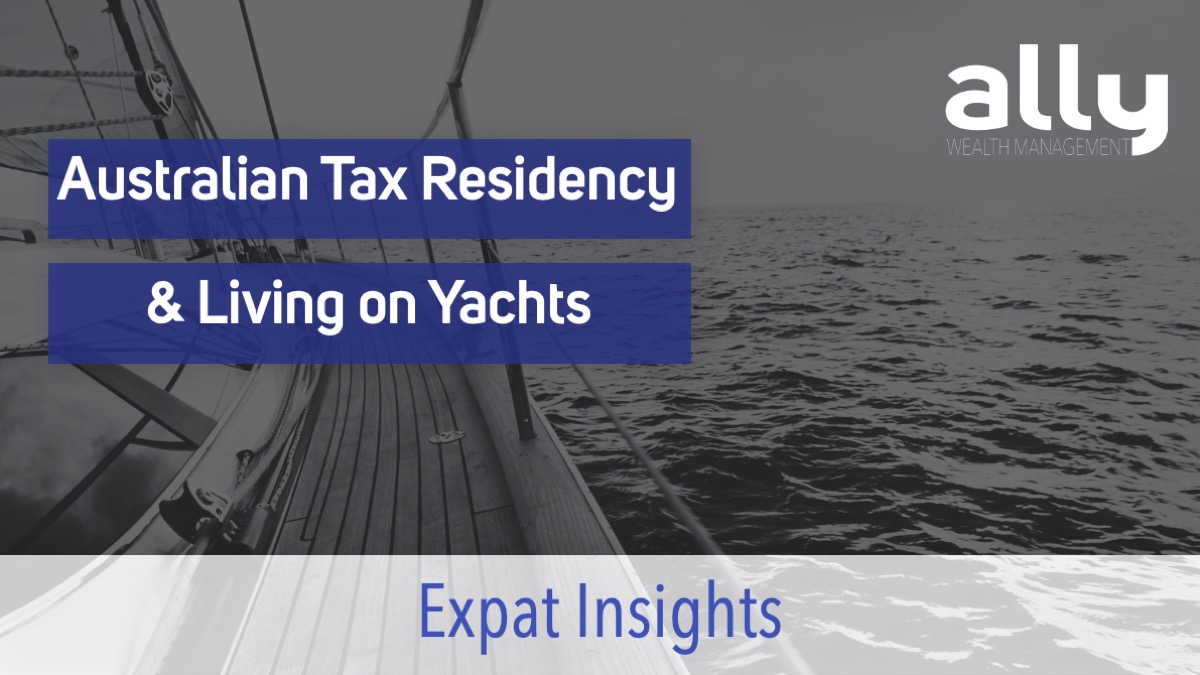Navigating US & Australia Tax Residency for Aussie Expats
Relocating to the United States is an exciting opportunity. Whether you’re moving for work, to be closer to family, or just for a change of scenery, the experience can be both thrilling and overwhelming. However, as you pack your bags and prepare for this significant life change, there’s one crucial aspect you shouldn’t overlook—your tax residency status. Understanding how your move affects your tax obligations is vital, as it directly impacts how much tax you’ll pay, where you’ll pay it, and how your assets are treated.
In this blog, we’ll guide you through the basics of US and Australian tax residency, focusing on the tests used by each country to determine your status and what the implications are if you end up being a tax resident in either—or both—countries. Let’s start by understanding what it means to be a tax resident in the US and Australia.
Understanding US Tax Residency
The United States has a clear and straightforward approach when it comes to determining tax residency. Unlike Australia, where residency can be subjective and based on various factors, the US primarily relies on a day count test known as the Substantial Presence Test.
The Substantial Presence Test
The Substantial Presence Test is the US’s main method for determining whether you’re a tax resident. Here’s how it works:
- The 183-Day Rule: If you spend 183 days or more in the US during a calendar year, you’re considered a tax resident for that year.
- The Three-Year Calculation: The test doesn’t just look at the current year; it considers your presence in the US over a three-year period:
- All the days you were present in the US in the current year.
- One-third of the days you were present in the US in the previous year.
- One-sixth of the days you were present in the US two years before the current year.
- If the total of these three figures equals or exceeds 183 days, you’re considered a US tax resident.
Exceptions and Considerations
While the Substantial Presence Test is straightforward, there are exceptions and special considerations. For example, if you’re on a visa like the E-3 (a visa specifically for Australians working in the US), you might be exempt from this test under certain conditions, such as if you can demonstrate closer ties to Australia or if your stay is only temporary.
However, generally speaking, if you’re moving to the US for at least two years, the assumption is that you will become a US tax resident on the date you relocate.
Implications of US Tax Residency
So, what does it mean if you become a US tax resident? Essentially, it means that the US tax system views you as a permanent member of its tax base. Here’s what you need to know:
- Worldwide Income: As a US tax resident, you’re required to report and pay tax on your worldwide income. This includes not just the income you earn in the US, but also any income you receive from Australia or other countries.
- Reporting Requirements: In addition to your income, you’ll need to report foreign assets, including bank accounts, investments, and property. The penalties for failing to report foreign assets can be severe, so it’s important to stay on top of these requirements.
- Tax Returns: You’ll need to file an annual tax return with the Internal Revenue Service (IRS), even if your income is below the taxable threshold. The US tax year runs from January 1st to December 31st, and your tax return is generally due by April 15th of the following year.
It’s also worth noting that the US has a progressive tax system, meaning that your tax rate increases as your income increases. While you may be able to claim some deductions or credits, the overall tax burden in the US can be significant, especially if you’re earning a high income.
Understanding Australian Tax Residency
Now that you’ve got a handle on how the US determines tax residency, let’s turn our attention to Australia. Unlike the US, Australia’s approach to tax residency is more complex and can be somewhat subjective. The Australian Taxation Office (ATO) uses a combination of tests to determine whether you’re a tax resident.
The Residency Tests
In Australia, there are several tests used to determine your tax residency status. Let’s break them down:
- The Resides Test: This is the primary test for tax residency in Australia. It considers whether you “reside” in Australia, which involves looking at where you live, where your family lives, your work situation, and other personal circumstances. It’s a holistic approach, and no single factor is decisive on its own.
- The Domicile Test: Even if you don’t pass the Resides Test, you can still be considered an Australian tax resident if your permanent home (domicile) is in Australia. This test is particularly relevant if you’ve maintained a home in Australia, even if you’ve been living overseas.
- The 183-Day Test: Similar to the US, Australia also has a 183-day rule. If you’re physically present in Australia for more than 183 days in a financial year (July 1st to June 30th), you may be considered a tax resident. However, if you can prove that your usual place of abode is outside Australia and you have no intention to reside in Australia, you might not be considered a resident.
- The Superannuation Test: This test is unique to Australia and applies primarily to government employees. If you’re a member of certain superannuation funds for Commonwealth government employees, you’re considered an Australian tax resident, regardless of your actual physical presence in Australia.
Implications of Australian Tax Residency
What happens if you’re still considered an Australian tax resident while living in the US? There are a few key points to consider:
- Worldwide Income: Like the US, Australia taxes its residents on their worldwide income. This means that if you’re an Australian tax resident, you’ll need to report and pay tax on any income you earn in the US or elsewhere.
- Tax Filing Requirements: As an Australian tax resident, you’ll need to lodge an annual tax return with the ATO. The Australian tax year runs from July 1st to June 30th, and tax returns are generally due by October 31st of the following year.
- Double Taxation: One of the biggest concerns for dual tax residents is the potential for double taxation—being taxed twice on the same income by both Australia and the US. Fortunately, there’s a tax treaty in place between the two countries designed to prevent this from happening. We’ll explore this in more detail later in the blog.
Relocating to the US: What Happens to Your Australian Tax Residency?
If you’re planning to relocate to the US, one of the first questions you’ll need to ask is what happens to your Australian tax residency. The answer largely depends on how long you plan to stay in the US.
Relocating for At Least 2 Years
Generally speaking, if you’re relocating to the US for at least two years, you’ll likely be considered a non-resident of Australia from the date of your relocation. This means that you’ll no longer be required to report your worldwide income to the ATO, and you won’t need to pay Australian tax on your US earnings. However, this isn’t automatic—there are still factors that the ATO will consider, such as whether you’ve maintained a home in Australia, whether your family has remained in Australia, and whether you have any ongoing Australian ties.
Relocating for Less Than 2 Years
If you’re moving to the US for less than two years, things get a bit more complicated. In this case, the ATO may still consider you an Australian tax resident, even while you’re living and working in the US. This is because your stay in the US is considered temporary, and you’re expected to return to Australia at some point. As a result, you may still need to file an Australian tax return and report your worldwide income, including any income earned in the US.
Potential for Dual Tax Residency
One of the complexities of relocating to another country is the possibility of being considered a tax resident of both countries—what’s known as dual tax residency. This can happen if you meet the residency criteria in both the US and Australia. For example, if you’re living in the US for an extended period but still maintain significant ties to Australia, both countries may consider you a tax resident.
Dual tax residency can create a number of challenges, including the potential for double taxation. Fortunately, there’s a tax treaty in place between the US and Australia that includes what’s known as a tie-breaker test, designed to determine which country has the primary right to tax you. We’ll explore this tie-breaker test in the next section of the blog.
The US-Australia Tax Treaty: Tie-Breaker Rules
When you find yourself in the tricky situation of being considered a tax resident in both the US and Australia, it’s essential to understand how the tie-breaker rules in the US-Australia tax treaty work. These rules are designed to prevent you from being taxed twice on the same income, which could otherwise put a significant strain on your finances.
Understanding the Tax Treaty
The tax treaty between the US and Australia is an agreement that helps resolve situations where a person might be considered a tax resident in both countries. The treaty contains specific provisions, known as tie-breaker rules, which determine in which country you’ll be treated as a resident for tax purposes. These rules are crucial because they ensure you’re only taxed as a resident in one country, helping to avoid the complications of dual tax residency.
Tie-Breaker Test: How It Works
The tie-breaker test involves several steps, each considering different aspects of your life to determine your primary country of residency. Here’s a breakdown of how it works:
- Permanent Home: The first step in the tie-breaker test is to look at where your permanent home is. If you have a permanent home in only one country, you’ll be considered a resident of that country for tax purposes. A permanent home can be a house, an apartment, or any other place where you live regularly.
- Centre of Vital Interests: If you have a permanent home in both countries or neither, the next step is to consider where your centre of vital interests lies. This involves looking at where your personal and economic ties are stronger. Factors like where your family lives, where you work, where your business interests are, and where you participate in social activities all come into play here.
- Habitual Abode: If it’s still unclear which country you have closer ties to, the tie-breaker test moves to consider where you have your habitual abode—basically, where you spend most of your time. If you spend more time in one country than the other, that country is more likely to be considered your primary residence.
- Nationality: If the tie-breaker test still doesn’t resolve the issue, the next consideration is your nationality. If you’re a citizen of one country but not the other, you’ll generally be considered a resident of the country of your nationality.
- Mutual Agreement Procedure: In rare cases where none of the above criteria resolve the residency issue, the tax authorities of both countries will work together to reach a mutual agreement on where you should be considered a resident.
Practical Implications of the Tie-Breaker Rules
Understanding and applying the tie-breaker rules can be complex, but they’re essential for determining where you should file your tax returns and which country has the right to tax your income. If you’re considered a tax resident of the US under the tie-breaker rules, you’ll be required to report your worldwide income to the IRS. On the other hand, if you’re deemed a resident of Australia, you’ll report your income to the ATO.
In some cases, the tie-breaker rules can result in you being treated as a non-resident in both countries, which can be advantageous from a tax perspective. However, this is rare and depends on specific circumstances, so it’s important to seek professional advice.
Tax Filing Requirements and Obligations
Once your tax residency status is determined, it’s crucial to understand your tax filing obligations in both the US and Australia. Even if you’re only a resident in one country, you may still have to file tax returns or report income in the other country, depending on the situation.
US Tax Filing Obligations
If you’re considered a US tax resident, you’ll have several filing obligations:
- File a US Tax Return: As a US tax resident, you must file an annual tax return with the IRS, reporting your worldwide income. This includes any income you earn in Australia, such as rental income, dividends, or interest.
- Report Foreign Assets: You’ll also need to report any foreign financial accounts or assets, including bank accounts, investment accounts, and property in Australia. This is done through the Foreign Bank Account Report (FBAR) and the Foreign Account Tax Compliance Act (FATCA). The penalties for failing to report these assets can be severe, so it’s essential to comply with these requirements.
- Claiming Foreign Tax Credits: If you’re paying tax on your Australian income in both the US and Australia, you may be able to claim a foreign tax credit on your US tax return. This credit helps to reduce your US tax liability, preventing double taxation on the same income.
Australian Tax Filing Obligations
If you remain an Australian tax resident while living in the US, or if you’re earning Australian-sourced income, you’ll also have obligations with the ATO:
- Lodge an Australian Tax Return: As an Australian tax resident, you’re required to lodge an annual tax return with the ATO, reporting your worldwide income, including any income earned in the US.
- Report Foreign Income: Just like the US, Australia requires you to report any foreign income, such as salary, dividends, or rental income from US properties. This income will be taxed in Australia, but you may be eligible to claim a foreign income tax offset to reduce your Australian tax liability.
- Capital Gains Tax: If you sell any assets while you’re an Australian tax resident, you may be liable for capital gains tax (CGT) in Australia. This includes assets located in both Australia and overseas.
- Superannuation Contributions: If you’re still making contributions to your Australian superannuation fund while living in the US, it’s important to understand how these contributions are taxed in both countries. The US may treat superannuation differently than Australia, so it’s crucial to get advice on how to manage your retirement savings.
Avoiding Double Taxation
One of the biggest concerns for Australians relocating to the US is the risk of double taxation—being taxed on the same income by both countries. Fortunately, the US-Australia tax treaty includes provisions that help to prevent this.
- Foreign Tax Credits: As mentioned earlier, both countries allow you to claim a foreign tax credit for taxes paid in the other country. This credit helps to reduce your tax liability, ensuring you’re not taxed twice on the same income.
- Exemptions and Deductions: The tax treaty also provides exemptions and deductions for certain types of income, such as pensions or annuities. These provisions can help to minimize your tax burden and ensure you’re only paying tax where it’s due.
- Consulting a Tax Professional: To navigate the complexities of dual tax residency and avoid double taxation, it’s essential to consult a tax professional who’s experienced in both US and Australian tax laws. They can help you understand your obligations, claim the right credits and deductions, and ensure you’re compliant with both countries’ tax regulations.
Conclusion
Understanding your tax residency status when relocating to the US is essential for managing your tax obligations and minimizing your tax burden. Whether you’re moving for a few years or planning a permanent relocation, knowing how the US and Australia determine tax residency—and the implications of each—will help you make informed decisions and avoid potential pitfalls.
By planning ahead, keeping detailed records, and consulting with a tax professional, you can navigate the complexities of dual tax residency and ensure you’re compliant with both US and Australian tax laws. So, as you embark on this exciting new chapter, take the time to understand your tax obligations and set yourself up for financial success.
Ally Wealth Management is the trusted ally in finance for Australians at home and across the globe. As both Australian expats and residents, the founders of Ally have a unique understanding of the common personal financial challenges faced.
Book your complimentary appointment with our team at Ally Wealth Management to discuss how we can help you to achieve your financial goals.
Ally Wealth Management Pty Ltd is a Corporate Authorised Representative of Sentry Advice Pty Ltd ABN 77 103 642 888. Sentry Advice holds an Australian Financial Services Licence (AFSL) No. 227 748.
General Advice Warning: The information contained herein is of a general nature only and does not constitute personal advice. You should not act on any recommendation without considering your personal needs, circumstances, and objectives. We recommend you obtain professional financial advice specific to your circumstances.




